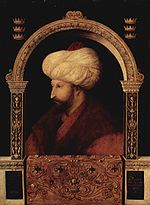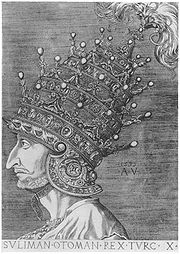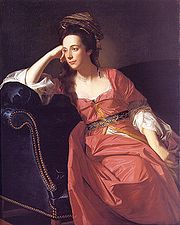
Turquerie
Encyclopedia



Orientalism
Orientalism is a term used for the imitation or depiction of aspects of Eastern cultures in the West by writers, designers and artists, as well as having other meanings...
fashion in Western Europe
Western Europe
Western Europe is a loose term for the collection of countries in the western most region of the European continents, though this definition is context-dependent and carries cultural and political connotations. One definition describes Western Europe as a geographic entity—the region lying in the...
from the 16th to 18th centuries for imitating aspects of Turkish art and culture. Many different Western European countries were fascinated by the exotic and relatively unknown culture of Turkey
Turkey
Turkey , known officially as the Republic of Turkey , is a Eurasian country located in Western Asia and in East Thrace in Southeastern Europe...
, which was the center of the Ottoman Empire
Ottoman Empire
The Ottoman EmpireIt was usually referred to as the "Ottoman Empire", the "Turkish Empire", the "Ottoman Caliphate" or more commonly "Turkey" by its contemporaries...
, and at the beginning of the period the only power to pose a serious military threat to Europe. The West had a growing interest in Turkish-made products and art, including music, visual arts, architecture, and sculptures. This fashionable phenomenon became more popular through trading routes and increased diplomatic relationships between the Ottomans and the European nations, exemplified by the Franco-Ottoman alliance
Franco-Ottoman alliance
The Franco-Ottoman alliance, also Franco-Turkish alliance, was an alliance established in 1536 between the king of France Francis I and the Turkish ruler of the Ottoman Empire Suleiman the Magnificent. The alliance has been called "the first non-ideological diplomatic alliance of its kind between a...
and Persian embassy to Louis XIV
Persian embassy to Louis XIV
The Persian embassy to Louis XIV caused a dramatic flurry at the court of Louis XIV in 1715, the year of the Sun King's death. Mohammed Reza Beg, or in French sources Méhémet Riza Beg, was a high-ranking official to the Persian governor of the Yerevan province...
in 1715. Ambassadors and traders often returned home with tales of exotic places and souvenirs of their adventures.
The movement was often reflected in the art of the period. Music, paintings, architecture, and artifacts were frequently inspired by the Turkish and Ottoman styles and methods. Paintings in particular portrayed the Ottomans with bright colours and sharp contrasts, suggesting their interesting peculiarity and exotic nature.
History of the movement
In the wake of the Age of Exploration, roughly between the 15th and 18th centuries, there was an explosion in the number of commodities and availability of products. People were using newly created cartography and using these maps to explore the world on paper. There was an accumulation of more objects and a desire for more acquisitions. Coupling this, there was the value of exoticismExoticism
Exoticism is a trend in art and design, influenced by some ethnic groups or civilizations since the late 19th-century. In music exoticism is a genre in which the rhythms, melodies, or instrumentation are designed to evoke the atmosphere of far-off lands or ancient times Exoticism (from 'exotic')...
, valuing things that came from a great distance. Europeans and Ottomans alike were developing a consciousness of themselves in relation to the broader world. At the same time the Ottomans were slowly ceasing to be regarded as a serious military threat to Western Europe, despite their continuing occupation of the Balkans
Balkans
The Balkans is a geopolitical and cultural region of southeastern Europe...
, and campaigns such as that ended by the Battle of Vienna
Battle of Vienna
The Battle of Vienna took place on 11 and 12 September 1683 after Vienna had been besieged by the Ottoman Empire for two months...
as late as 1683.
New patterns of consumption were arising, especially with trading ships being able to navigate around Africa. Commodities that were once expensive were becoming more affordable. Products often define people in terms of gender, age, and availability of access. This notion of social definition outlines the main theme of the explosion of commodities from 16th century and onwards. The exchange system had to do precisely with accessibility and availability of commodities on a grand scale. It is important to note that this was not just a European phenomenon. The Europeans were not the only people who developed a sensibility of how consuming different things could define their relationships domestically and abroad. In this context, there was a broader view of consumption and one’s place within the world. A person would consume in order to show off their financial position and their social location. Coffee is an example of a commodity that became more popular as Europeans “discover” it in Ottoman lands and experience it. Turquerie would not be just about furnishings, decorations, art, fashion, and clothing, but also what people put in their bodies.
European perspective
There is something unique about ways Europeans developed views of exoticism as greater emphasis is put on empire building and colonies in other nations. There was a growing fashion for Turkish styles in Europe in the 15th and 16th centuries. The Europeans began to see Ottomans not as worthy rivals that they had to contend with and imitate militarily, politically, or diplomatically, rather as having quaint and strange fashions that could be consumed. Consuming these exotic fashions would show one’s elite place in society as well as display their open mindedness and interest in the world. This fashionability is brought by the presence of Europeans in the Ottoman Court and the acts of bringing back their products to Europe. The increased mercantile relationships between the Turkish people and the Europeans aided this process. The continuation of these trading systems help spread the new fashions quickly in Europe.Decorations and patterns
A brightly-coloured Turkish style of decoration was used on many types of objects, including timepieces. Many of those imported had the hours and creator’s name in Arabic characters. A person who owned one of these timepieces was one with an increased social status.The Turkish grandeur portrayed by the sultans could be attractive to Europeans. Agostino Veneziano
Agostino Veneziano
Agostino Veneziano, whose real name was Agostino de' Musi, was an important and prolific Italian engraver of the Renaissance.-Life:...
made a portrait of Suleyman the Magnificent, sultan of the Ottoman Empire in 1520. He was known as the “grand Turk” and constantly disrupted European balance. The image portrays the sultan as a gentle, yet barbaric person. He was most known for executing the wishes of the sultana, Roxelana
Roxelana
Haseki Hürrem Sultan was the wife of Süleyman the Magnificent of the Ottoman Empire.-Names:Sixteenth-century sources are silent as to her maiden name, but much later traditions, for example Ukrainian folk traditions first recorded in the 19th century, give it as "Anastasia" , and Polish...
, who wanted their children murdered to secure the throne for one of their sons.
Fabrics were often bright, rich, and embroidered, as depicted in the painting, Himan de la Grande Mosquee by Joseph-Marie Vien
Joseph-Marie Vien
Joseph-Marie Vien , French painter, was born at Montpellier. He was the last holder of the post of Premier peintre du Roi, serving from 1789 to 1791....
in 1748. In the context of turquerie, Turkish textiles were also a luxury in the elitist European homes. They often
had velvet grounds with stylized floral motifs. They were often woven in Asia Minor for the European market or, more commonly, as Venetian, under Turkish influence. Italian-styled textiles were often woven by the Ottoman Turks for the Venetians because of their cheap labour and continued business relationships.
Portraits: European and American

Lady Mary Wortley Montagu
The Lady Mary Wortley Montagu was an English aristocrat and writer. Montagu is today chiefly remembered for her letters, particularly her letters from Turkey, as wife to the British ambassador, which have been described by Billie Melman as “the very first example of a secular work by a woman about...
. Montagu went to Turkey in 1717 when her husband was posted as ambassador there. Her collected letters while there, describing Turkish fashion, were distributed widely in manuscript form. They were then printed upon her death in 1762. Her letters helped shape how Europeans interpreted the Turkish fashion and how to dress. This phenomenon eventually found its way across the Atlantic and in colonial America, where Montagu’s letters were also published.
Opera
In 18th century Europe, it was in fashion to smoke Turkish tobacco in a Turkish pipe, wearing a Turkish robe, all while in an elaborate Turkish costume. European opera was influenced heavily by the idea of turquerie. Mehmed IIMehmed II
Mehmed II , was Sultan of the Ottoman Empire for a short time from 1444 to September 1446, and later from...
(1451–1481), the conqueror who is considered the founder of the Ottoman Empire, had many operas written about him. His defeat of Constantinople
Constantinople
Constantinople was the capital of the Roman, Eastern Roman, Byzantine, Latin, and Ottoman Empires. Throughout most of the Middle Ages, Constantinople was Europe's largest and wealthiest city.-Names:...
in 1453 was the basis of the German opera Mehmed II, composed by Reinhard Keiser
Reinhard Keiser
Reinhard Keiser was a popular German opera composer based in Hamburg. He wrote over a hundred operas, and in 1745 Johann Adolph Scheibe considered him an equal to Johann Kuhnau, George Frideric Handel and Georg Philipp Telemann , but his work was largely forgotten for many...
in 1693. As well, there were many operas based on the ongoing conflicts between Timur
Timur
Timur , historically known as Tamerlane in English , was a 14th-century conqueror of West, South and Central Asia, and the founder of the Timurid dynasty in Central Asia, and great-great-grandfather of Babur, the founder of the Mughal Dynasty, which survived as the Mughal Empire in India until...
and Beyazid I, including Tamerlano
Tamerlano
Tamerlano is an opera in three acts written for the Royal Academy of Music , with music by George Frideric Handel to an Italian text by Nicola Francesco Haym, adapted from Agostin Piovene's Tamerlano together with another libretto entitled Bajazet after Nicolas Pradon's Tamerlan, ou La Mort de...
by George Handel. These stories of perseverance and passion appealed to many Europeans and therefore gained popularity. One of France
France
The French Republic , The French Republic , The French Republic , (commonly known as France , is a unitary semi-presidential republic in Western Europe with several overseas territories and islands located on other continents and in the Indian, Pacific, and Atlantic oceans. Metropolitan France...
’s most important opera genres was tragedie lyrique, depicted by Scanderberg, with music by François Rebel
François Rebel
François Rebel was a French composer of the Baroque era. Born in Paris, the son of the leading composer Jean-Féry Rebel, he was a child prodigy who became a violinist in the orchestra of the Paris Opera at the age of 13...
and Francois Francoeur
François Francoeur
François Francœur was a French composer and violinist.-Biography:He was born in Paris, the son of Joseph Francœur, a basse de violon player and member of the 24 violons du roy. Francœur was instructed in music by his father and joined the Académie Royale de Musique as a violinist at age 15...
and the libretto by Antoine Houdar de la Motte
Antoine Houdar de la Motte
Antoine Houdar de la Motte was a French author.He was born and died in Paris. In 1693 his comedy, Les Originaux, was a complete failure, and so depressed the author that he contemplated joining the Trappists. Four years later he began writing texts for operas and ballets, e.g...
in 1735. This opera was visually one of the most elaborate of the Turkish operas, with detailed scenic designs for mosques and seraglio courts. As well, many exotic characters were displayed.
Operas using themes from turquerie were in the usual European languages but tried to imitate the Turkish culture and customs. It offered a world of fantasy, splendor, and adventure that was unattainable by the average person. Audiences would be fascinated with the Turkish and Ottoman institutions depicted. The stories and implications as well as the extravagant costumes and elaborate staging appealed to the people. The Europeans craved reality in their depiction of the Turkish peoples. During performances, females would often be in the latest fashion, where local colour was suggested by foreign attire or numerous ornaments. The males tended to wear more authentic Turkish dress than the female, including a turban, sash, long caftan, and binding with rich material.
Music

The music in operas that utilized the notion of turquerie was not seriously influenced by Turkish music. Composers in the 18th century were not interested in ethnomusicology
Ethnomusicology
Ethnomusicology is defined as "the study of social and cultural aspects of music and dance in local and global contexts."Coined by the musician Jaap Kunst from the Greek words ἔθνος ethnos and μουσική mousike , it is often considered the anthropology or ethnography of music...
, to adopt the style of sound of a particular country or area. The European audiences were not yet ready to accept the unappealing and what they thought of as primitive musical style of the Turkish people. Traditional Turkish music included wavering pitches, microtones, arabesques, different scale systems, and non-Western rhythmic patterns. Europeans thought of this type of music, as Wolfgang Amadeus Mozart
Wolfgang Amadeus Mozart
Wolfgang Amadeus Mozart , baptismal name Johannes Chrysostomus Wolfgangus Theophilus Mozart , was a prolific and influential composer of the Classical era. He composed over 600 works, many acknowledged as pinnacles of symphonic, concertante, chamber, piano, operatic, and choral music...
once said, "offensive to the ears." Having short spurts of it in the operas were common, but just to add comedic affect.
Further reading
- Grabar, Oleg. "An Exhibition of High Ottoman Art." Muqarnas, Vol. 6. (1989), pp. 1–11.
- Meyer, Eve R. "Turquerie and Eighteenth-Century Music." Eighteenth-Century Studies, Vol. 7, No. 4. (Summer, 1974), pp. 474–488.

